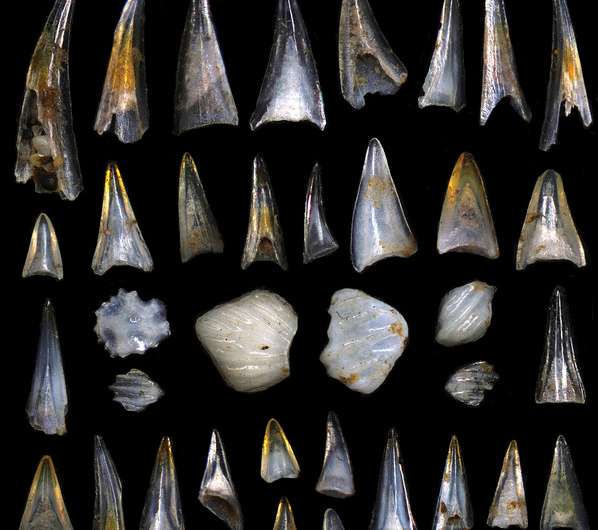End of the dinosaurs gave rise to the modern 'Age of Fishes,' researchers find

A pair of paleobiologists from Scripps Institution of Oceanography, UC San Diego have determined that the world's most numerous and diverse vertebrates – ray-finned fishes – began their ecological dominance of the oceans 66 million years ago, aided by the mass extinction event that killed off dinosaurs.
Scripps graduate student Elizabeth Sibert and Professor Richard Norris analyzed the microscopic teeth of fishes found in sediment cores around the world and found that the abundance of ray-finned fish teeth began to explode in the aftermath of the mass die-off of species, which was triggered by an asteroid strike in the Yucatan Peninsula. Scientists refer to this episode as the Cretaceous-Paleogene (K/Pg) extinction event.
Ninety-nine percent of all fish species in the world – from goldfish to tuna and salmon – are classified as ray-finned fishes. They are defined as species with bony skeletal structures and have teeth that are well preserved in deep ocean mud. Sharks, in contrast, have cartilaginous skeletons and are represented by both teeth and mineralized scales, also known as denticles, in marine sediments.
"We find that the extinction event marked an ecological turning point for the pelagic marine vertebrates," write the authors in the study. "The K/Pg extinction appears to have been a major driver in the rise of ray-finned fishes and the reason that they are dominant in the open oceans today."
The breakthrough for the researchers in reaching their conclusion came through their focus on fossilized teeth and shark scales. In cores from numerous ocean basins, they found that while the numbers of sharks remained steady before and after the extinction event, the ratio of ray-finned fish teeth to shark teeth and scales gradually rose, first doubling then becoming eight times more abundant 24 million years after the extinction event. Now there are 30,000 ray-finned fish species in the ocean, making this class the most numerically diverse and ecologically dominant among all vertebrates on land or in the ocean.
Scientists had known that the main diversification of ray-finned fishes had happened generally between 100 million and 50 million years ago.
"The diversification of fish had never been tied to any particular event. What we found is that the mass extinction is actually where fish really took off in abundance and variety," said Sibert, who is the recipient of an NSF Graduate Research Fellowship. "What's neat about what we found is that when the asteroid hit, it completely flipped how the oceans worked. The extinction changed who the major players were."
Sibert and Norris believe that some key changes in the oceans might have helped ray-finned fishes along. Large marine reptiles disappeared during the mass extinction, as did the ammonites, an ancient cephalopod group similar to the chambered nautilus. Those species, the researchers believe, had been either predators of ray-finned fishes or competitors with them for resources.
"What's amazing," said Norris, "is how quickly fish double, then triple in relative abundance to sharks after the extinction, suggesting that fish were 'released' from predation or competition by the extinction of other groups of marine life."
Sibert noted that before the extinction event, ray-finned fishes existed in a state of relative ecological insignificance, just like mammals on land.
"Mammals evolved 250 million years ago but didn't become really important until after the mass extinction. Ray-finned fishes have the same kind of story," said Sibert. "The lineage has been around for hundreds of millions of years, but without the mass extinction event 66 million years ago, it is very likely that the oceans wouldn't be dominated by the fish we see today."
The paper, "New Age of Fishes initiated by the Cretaceous-Paleogene mass extinction," appears June 29 in the early edition version of the journal Proceedings of the National Academy of Sciences.
More information: "New Age of Fishes initiated by the Cretaceous−Paleogene mass extinction" PNAS 2015 ; published ahead of print June 29, 2015, DOI: 10.1073/pnas.1504985112
Journal information: Proceedings of the National Academy of Sciences
Provided by The Scripps Research Institute




















